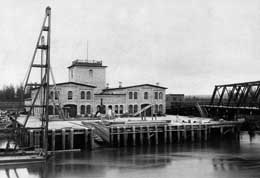By December 25, 1913, Sumner Iron Works (founded in Everett in 1892) moves into its new building in Lowell. The year has been an eventful one for the profitable and successful firm. In April 1913 the plant had burned to the ground, leaving few remains. A new site was quickly chosen on the north end of nearby Lowell, at 3rd and 41st streets. By December 25, 1913, the new building is sufficiently completed for the company to move in.
The Sumner Iron Works
As young men, brothers Thomas B. Sumner (1858-1934) and Frederick W. Sumner (ca. 1851-1927) began a business in rural Hutchinson, Minnesota, where they produced ploughs, harrows, portable engines, and sleighs. As their business prospered, they sought new opportunities and a new location and, following the advice of James J. Hill (1838-1916), whom Fred had met as a Minnesota legislator, the Sumners decided to move west. Sumner Iron Works was incorporated in 1892 and the Sumner brothers built a handsome brick foundry in Everett on the east bank of the Snohomish River, at the end of the Everett Avenue Bridge. They moved their Hutchinson firm -- equipment and employees -- to Everett.
The national Panic of 1893 presented a considerable challenge to the new firm. Nearly half the money bankers promised did not come through. Although its primary business would continue to be production of sawmill machinery, its first contract was to produce six ore cars for use in the Monte Cristo mines (located in eastern Snohomish County).
During the 1897 gold rush, Sumner Iron Works gained business and was innovative in producing mining equipment that used steel instead of wood, thus extending equipment life and making it possible to double the capacity of the ore concentrator. But the body of the plant’s work was for lumbering. Product catalogs produced by Sumner Iron display hundreds of machines and parts produced for the lumber and shingle trade.
Thomas Sumner was a politician as well, serving as one of Everett’s first city councilmen and as Washington State senator in the 1901, 1903, and 1905 sessions.
The Fire and After
On April 4, 1913, the Sumner Iron Works was destroyed by fire. The Sumners quickly chose a new plant location and broke ground in August at 41st and 3rd streets in Lowell. Sumner Iron Works continued its business, temporarily renting the idle Phoenix Iron Works in Tacoma while the new plant was being built.
Everett photographer John A. Juleen (1874-1935) was hired to document the building of the new plant. By Christmas of 1913, only a little more than eight months after the fire, the plant was sufficiently completed to begin moving in. By early 1914, the new plant was in full production.
During World War I, Sumner Iron Works shifted to wartime production of ship machinery and steam engines. After the war, it produced mill, cannery, and marine machinery.
In 1919 Sumner merged with McKelvie and Alton Engineering Company of Vancouver, British Columbia, and a new plant was built Summerton, B.C., five miles south of Vancouver. The company was now under the leadership of a second generation of Sumners, sons George and Frank. George managed the Canadian facility and Frank stayed in Everett. As economy recovered, the company concentrated on production of pulp mill machinery and was a leading supplier to Pacific Coast mills.
In the mid-1930s, Sumner Iron Works reorganized and sold to a group of Everett businessmen. Frank continued as vice-president and purchasing agent. During World War II, Sumner Iron Works produced marine equipment for the war. Sumner’s reputation for filling contracts ahead of schedule gained recognition from the United States government, which awarded the firm the Maritime “M” Pennant, the Victory Fleet Flag and the Maritime Merit Badge.
In 1962, the plant was sold to the firm Black and Clawson in 1962 and operated under that name until it became the Acrowood Corporation in 1985. The business presently continues at the Lowell site. The 1913 Sumner building is a functioning part of Acrowood, which manufactures heavy equipment for the pulp and paper industry.

